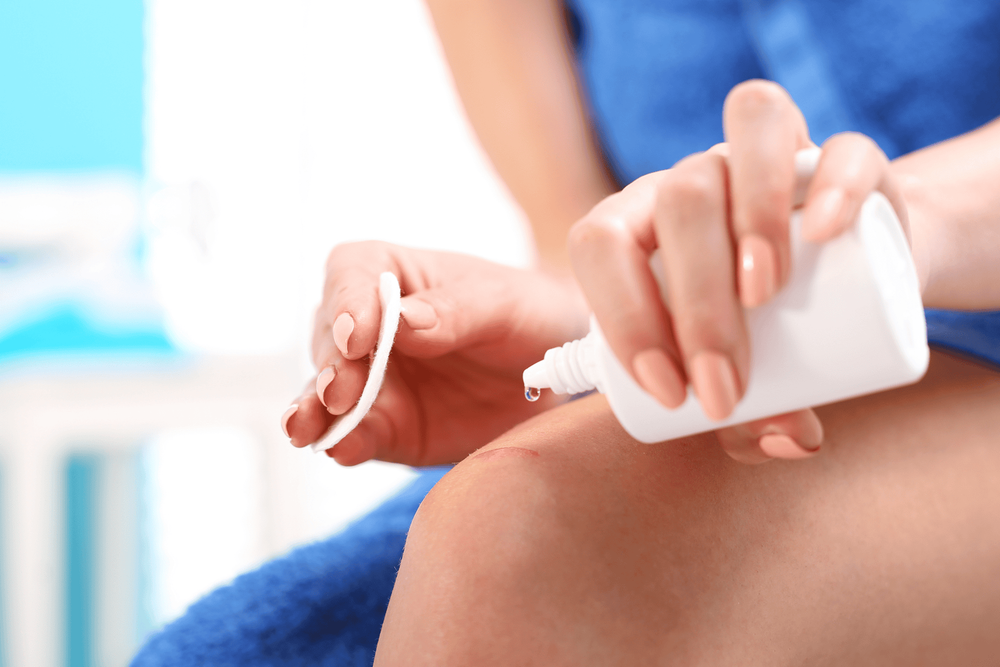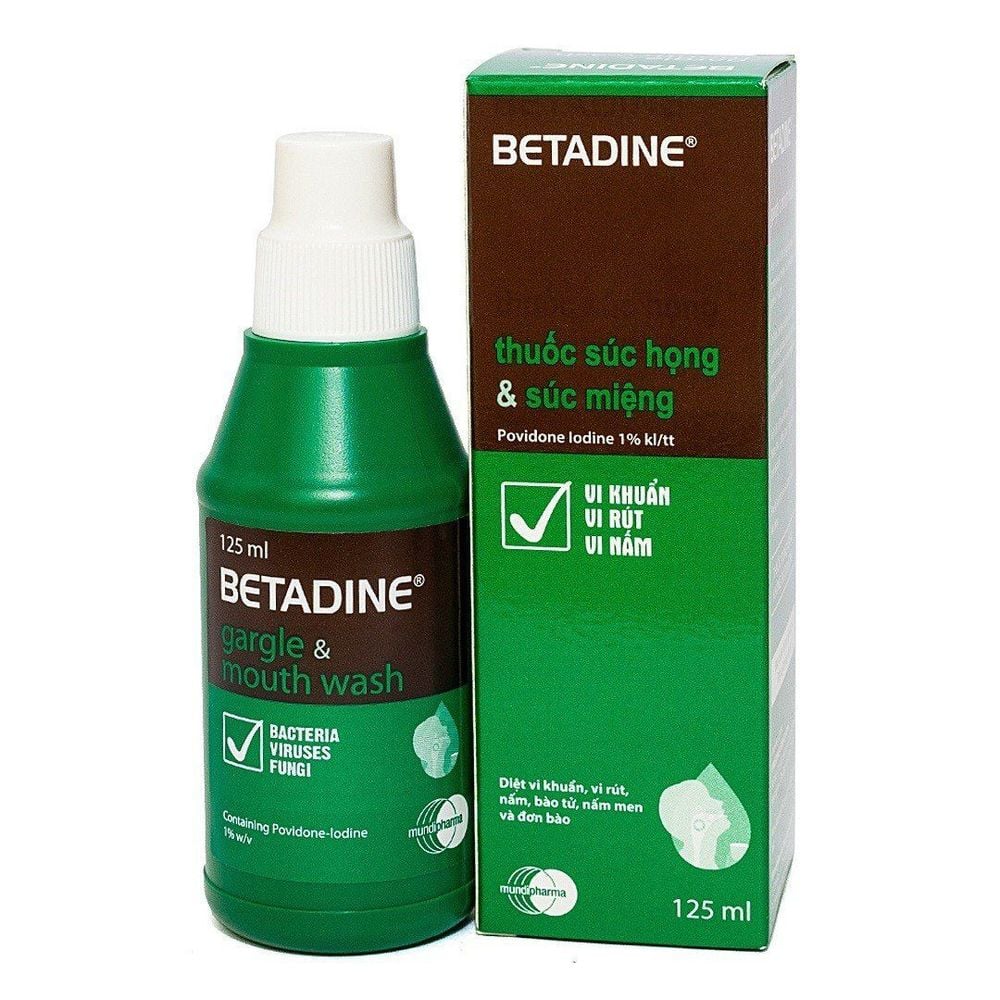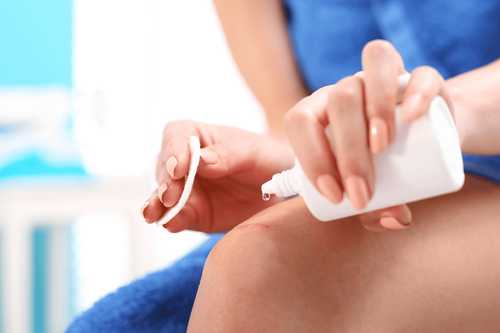This is an automatically translated article.
The article was professionally consulted with Master, Doctor Phan Ngoc Toan - Resuscitation - Emergency Doctor - Vinmec Danang International General Hospital.In most family medicine cabinets, there is at least one type of wound antiseptic solution, to disinfect when unfortunately cut hands, skin scratches due to falls, scratches, ... However, not all Everyone knows how to use the wound antiseptic solution correctly. The incorrect selection and use of antiseptic solutions may bring unwanted side effects.
1. Common types of wounds
First, we need to briefly grasp the common types of injuries. Wound is a condition that disrupts the integrity and loss of function of tissues. Wounds have the following basic characteristics:Impairment of physiological function of tissues. There may or may not be a loss of skin integrity. May damage skin or underlying structures. Wounds are divided into two main categories, namely:
Acute Wounds : are wounds encountered due to trauma or surgery. Chronic wounds: are pressure sores (common in stroke patients, lying for a long time in one position), vascular ulcers, foot damage in diabetics,...
2. Why wash the wound?
We must wash the wound because it helps to reduce the planktonic bacteria, clean the debris, accumulation and inflammatory fluid. However, washing the wound can also cause tissue damage. Whether disinfecting a wound is beneficial or harmful depends on the pressure used to clean the wound and the antiseptic solution itself used.The basic requirements of a wound antiseptic solution are:
Do not damage the wound tissue. Not toxic to the body when used on a large scale. Killing bacteria, especially decomposing biofilms - a biofilm made by microorganisms (bacteria, viruses, ..) and cells that stick together on the wound surface. Capable of permeating organizations.

3. Commonly used wound antiseptic solutions
Commonly used wound antiseptic solutions are:Salt water Ringer solution Hydrogen peroxide Sodium hypochlorite acetic acid Alcohol Ionized silver preparations Chlorhexidine Polyhexanide/Betaine Povidone-iodine ...
3.1. Salty water
This is a widely used wound antiseptic solution. This solution does not reduce biological burden or improve wound healing.3.2. Alcohol
Alcohol is often used to disinfect skin and wound surfaces. The alcohol concentration to achieve antibacterial effect is > 50%, it is recommended to use alcohol from 60-90%, preferably 70 degrees alcohol.The mechanism of action of the alcohol solution is to denature the protein of microorganisms, which has the effect of killing bacteria, fungi and viruses, but it has no effect on spores. High concentrations of alcohol also have the ability to denature bacterial proteins, but because of the high alcohol content, it accidentally creates an outer shell that protects the inside of bacteria from the effects of alcohol. On the other hand, alcohol solution with high concentration will be easier to fly, so it also reduces the effectiveness of the medium.
In addition to disinfecting the wound, alcohol solution is also used to disinfect tools, disinfect the skin before injection.
Care should be taken not to get into the eyes and not to drink alcohol.
3.3. Hydrogen peroxide
Hydrogen peroxide is a colorless solution of hydrogen peroxide in water with different concentrations (1.5%, 3%, 6%, 27%, 30%).To disinfect skin and wounds only use hydrogen peroxide with a concentration of 1.5%, 3%. Disinfect tools using hydrogen peroxide with a concentration of 6%. Hydrogen peroxide with a high concentration of 275, 30% is used to make thinner solutions, then it can be used. Hydrogen peroxide is used to:
Disinfect wounds and ulcers. Decontaminate skin and mucous membranes. Oral lavage in the treatment of acute stomatitis. Deodorant mouthwash. Clean the root canal and pulp cavity of the tooth. Ear drops to remove earwax. Treatment of purulent ear infections When using hydrogen peroxide to clean wounds, we often see bubbling on the wound surface. This phenomenon occurs because when injured, the blood and cells secrete the enzyme catalase, which catalyzes the decomposition reaction of hydrogen peroxide into water and oxygen. The white foam that rises is the new oxygen produced in the above reaction. That newborn oxygen has a very strong oxidizing effect, it will damage the bacterial cell membrane, DNA and some other components of the bacterial cell. At the same time, the effervescence phenomenon also has the effect of pushing dirt and pus out, so that the wound is cleaned.
However, hydrogen peroxide has the disadvantage that it has a weak antiseptic effect and only lasts for the time when oxygen is generated, which is a very short time. This antiseptic solution is not dangerous, but during use it is necessary to note a few points:
Hydrogen peroxide can cause irritation and cause "burns" of the skin and mucous membranes. To wash small wounds, only a dilute concentration of hydrogen peroxide has an antiseptic effect, so only 1.5% and 3% concentrations are usually used. Do not use hydrogen peroxide to wash the wound that is growing on young skin, because it will damage fibroblasts, making the wound heal longer. Hydrogen peroxide is only used for open wounds, do not use with closed areas or small into closed cavities of the body because when the oxygen is released, it will not be able to escape, so it can cause complications. dangerous as air embolism, air embolism. When using hydrogen peroxide in the ear, it is necessary to have indications and instructions of a specialist, because improper use can cause skin burns in the ear, ear necrosis, and narrowing of the ear canal. Hydrogen peroxide is for external use only, not for drinking because it can cause bloating, belching or some other dangerous complications. When rinsing, it is necessary to rinse quickly, when removing the root canal, use cotton wool soaked in solution and then proceed to bleach each position.
3.3. Purple Potion
The potassium permanganate is made in the form of a powder, when dissolved in water, it can be used. Take a medical cotton swab soaked in potassium permanganate solution to wash the wound on the skin and outside to kill some bacteria and disinfect the wound.Purple bleach is also used to wash raw vegetables. However, there are still some stubborn creatures such as roundworm eggs, hairworms, etc., which are usually not destroyed. Therefore, after washing the vegetables, it is necessary to soak the potassium permanganate for about 30 minutes.
3.4. Red Potion
Red medicine is an antiseptic solution for wounds, in addition to this effect, it also has anti-ulcer and wound-drying effects. However, you should not abuse this solution because it contains mercury.After disinfecting the wound with hydrogen peroxide or alcohol, you can apply red medicine to the wound. But with large wounds, deep wounds should not use red medicine to disinfect because mercury in contact with blood can be life-threatening.
3.5. Preparations containing iodine
Iodine has the effect of precipitating protein and oxidizing the main enzyme of bacteria. It is effective against many pathogenic bacteria, viruses and fungi.3.5.1. Iodine alcohol
Iodine alcohol is an antiseptic solution consisting of iodine, potassium, iodide and alcohol. Iodine alcohol has the disadvantage of being toxic, irritating to the skin and staining the skin. Therefore, do not use iodine alcohol solution with a concentration of more than 5% to disinfect. It is necessary to limit the use of this antiseptic solution on the face, sensitive skin and only used for skin wounds, not for deep, open wounds.3.5.2. Povidone iodine
Povidone iodide wound antiseptic solution is a complex of iodine and polyvinyl pyrolidon, which contains 9 - 12% idod. This solution releases iodine slowly and has a long-lasting effect on bacteria, viruses, fungi, protozoa, cocoons and stomachs. This solution is less effective than preparations containing free iodine, but less toxic, because the amount of free iodine is low, less than 1 part per million in a 10% solution.To disinfect wounds and disinfect skin, usually use povidone iodine 10%. For rinsing, use a 1% solution. In addition, there are other dosage forms such as:
Vaginal gel Vaginal hygiene solution Aerosol bottle contains spray powder Although Povidone iodide is less toxic than other iodine preparations, it can still cause irritation. Skin and mucous membranes, when used repeatedly on large wounds can cause systemic side effects. Commercial products often contain some detergents that interfere with wound healing, so rinse with water, or physiological saline after using povidone iodide.
3.6. Betaine 0.1% and Polyhexanide 0.1% (Prontoan)
Betaine has low surface tension so it easily penetrates deep into the tissue to help clean wounds, remove dead tissue and biofilm. Polyhexanide has antibacterial effect. This antiseptic solution has the following activities:No need for strong rinsing, it can still remove bacteria and debris. Reduces pseudomembranous formation on wounds, controls bacterial infections and biofilms. With chronic ulcers: it has the effect of stimulating healing, reducing the size of the wound. Has the effect of stimulating granulation tissue formation, does not cause damage to new granulomatous tissue. Has the effect of reducing wound exudate, reducing odor, and surrounding tissue reducing swelling, heat, redness, and pain. These two types of antiseptic solutions are used to:
Disinfect the skin. Antiseptic conjunctiva, mucosa, peritoneum, pleural cavity. Chronic wound surface disinfection. Disinfect the implant material. Polyhexanide/betaine is more cytotoxic than hydrogen peroxide. Polyhexanide induces chondrocyte death. Therefore, for joint wounds, it should be used for less than 15 minutes, and for joint surgery, it is necessary to wash immediately before closing the wound.

3.7. Berberine 0.1%
Berberin has been studied for a long time, it is an alkaloid. Many countries have used berberine to treat intestinal diseases, diarrhea, fatigue liver disease and to wash the wounds of war. In Vietnam, berberin is extracted from the bitter yellow tree - a plant used to treat dysentery and enteritis.Berberin has activity:
Kills bacteria such as: E.coli, S.aureus. Bacterial control: P.aeruginosa Local treatment: berberin reduces inflammation, reduces edema, inhibits some bacteria. For burn wounds: berberine is effective in granulation tissue growth, increasing the number of fibroblasts and neovascularization, facilitating skin grafting.
4. How to choose a wound antiseptic solution
Clean, sutured wounds: all kinds of wound cleaning solutions. Clean incision, closed suture: all kinds of wound cleaning solution. Wound abscess, purulent inflammation: If anaerobic bacteria infection is not suspected: all kinds of wound antiseptic solutions can be selected. If anaerobic infection is suspected, choose one of the following: hydrogen peroxide, Povidone iodine, Prontosan. Open wounds, chronic ulcers, burns: you can choose antiseptic solutions such as Polyhexanide, Betaine, Ionic Ag (Silver nitrate 0.25-0.5%, Berberin 0.1%. Wound antiseptic solution is an art in wound care.It both helps to maintain the wound in a clean condition while also supporting the rapid wound healing process.Please dial HOTLINE for more information or register for an appointment HERE. Download MyVinmec app to make appointments faster and to manage your bookings easily.









